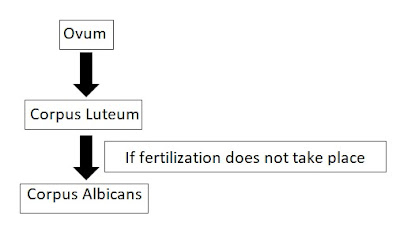Mechanism of Release Of Ovum (OVULATION)
-Souti Das
- During the 1st 5 months of development, a finite number of primordial follicles form in the fetal ovary, these follicles contain an oocyte surrounded by follicular cells. These primordial follicles arrests at 1st meiotic division till puberty and then they further undergo development and become primary follicles.
- During the early primary follicular stage, follicular cells are cuboidal and Zona Pellucida appears as a thin band of glycoprotein that separates oocyte and follicular cells. In the late follicular stage, follicular cells proliferate into a stratified epithelium known as Zona Granulosa.
- During the secondary follicular stage, proteoglycan riched antrum appears in the Grannulosa layer. Cell layers in the Zona Grannulosa increase and thereby Zona Pellucida gets thickened. In this stage theca cells appear outside the follicles, those contain enzymes for androgen formation from cholesterol with the help of aromatase enzyme present in the Granulosa cells.
- In the next stage follicular antrum increases in size, and the secondary oocyte completed its 1st meiotic division. Zona Pellucida got more prominent and various layers of corona radiate forms. With the help of LH and progesterone Graffian follicle moves toward the periphery of the ovary. New blood vessels are forms (angiogenesis) forms in the follicular cell wall, prostaglandin helps in the protrusion of blood vessels and thereby increases blood flow in the follicular cells. Leakage of plasma into the follicle causes swelling of follicular cells and after that follicular cells protruded in the ovarian capsule. At the end stigma is formed, the follicular cell is ruptured and ovum (contains Oocyte, Zona Pellucida, and Corona radiate) is released and the stigma degenerates.
 |
| Flowchart on release of ovum |
- After release of the ovum the remaining cells of the Grannulosa and theca interna forms corpus luteum, it contains steroid producing lutin granules. Blood vessels penetrate through it and allow them to take up cholesterol, to produce progesterone. If the ovum is fertilized and implanted in the uterine wall, LH level and corpus luteum is sustained.
- If fertilization does not occur, the cells of the corpus luteum remain active roughly for 14 days, until the level of LH fall and then involute to form corpus albicans, the secretory cells of the corpus luteum regenerate and phagocytised by macrophages and replaced by fibrous materials.


Comments
Post a Comment
please share it with your friends and students